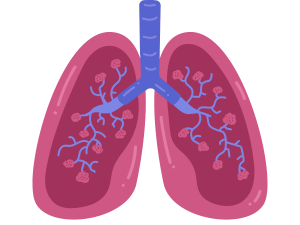This CDI scenario details a 67-year-old male with post procedural respiratory failure.
H&P: A 67-year-old male with Adenocarcinoma of the sigmoid colon presents to the surgery center for a laparoscopic colectomy.
PMH: Obesity BMI: 36.4, HTN, CHF, CAD, sigmoid colon cancer
Labs: WBCs:10.5> 11.6> 10.8; HGB:13.1 (pre-op)> 7.5 > 9.5> 9.0; ABGs (POD 1):pH 7.33; pCO2: 55; pO2: 51; SaO2: 88%; BNP:625
Vitals: HR 79-85, BP’s 169/87; 180/92; 175/82, RR: 16-28, Temp: 37.6-38.0, Sp02: 93 % on 7L HFNC,
Echo: EF 26%
CXR: Cardiomegaly with development of new pleural effusion. Likely acute CHF
Attending Progress Notes POD 1: incision c/d/I, BS absent, HGB dropped to 7.5 transfuse 2 units PRBC, crackles and pedal edema present. BNP & CXR ordered. Unable to wean past 7L. Suspect ADHF, will consult cardiology. Dx: Acute Postoperative Respiratory Failure, Anemia, Adenocarcinoma Sigmoid Colon s/p lap colectomy.
Cardiology Consult: Echo ordered, Acute on Chronic CHF. Lasix 40 mg IVP BID
Discharge Summary: Adenocarcinoma Sigmoid Colon s/p lap colectomy; Postoperative Respiratory Failure; CHF exacerbation, Obesity, Anemia s/p 2u PRBC, HTN, and CAD.

Question: Are there query opportunities based on the scenario stated above?
Discussion: The patient exhibited the following risk factors and clinical indicators.
- Post Procedural Respiratory Failure with noted increased O2 needs
- Acute on Chronic CHF documented with Echo finding of EF 26%
- Transfusion of 2u-PRBC
- Obesity documented with PMH of HTN, CHF and BMI 36.4
UASI Recommends:
- Query for etiology of Respiratory Failure in the postoperative period i.e. complication of procedure or due to CHF exacerbation
- Query for CHF type
- Query for ABLA
- Query for Morbid Obesity
Documentation without Clarification:
- Principle Diagnosis: Malignant Neoplasm of the Sigmoid Colon (C18.7)
- Secondary Diagnosis: Acute Post Procedure Respiratory Failure (J95.821), heart failure, unspecified (I50.9), Hypertensive heart disease with heart failure (I11.0), CAD (I25.10), Obesity (E66.9), BMI 36.0-36.9 (Z68.36)
- Procedure: Resection of Sigmoid Colon, Percutaneous Endoscopic Approach (0DTN4ZZ)
- Working DRG: 329 Major Small & Large Bowel Procedures with MCC
- RW: 4.8862 GMLOS: 10.3 SOI/ROM: 3/2
Documentation with Clarification:
- Principal Diagnosis: Malignant Neoplasm of the Sigmoid Colon (C18.7)
- Secondary Diagnosis: Acute Hypoxic Respiratory Failure (J96.01), Acute on Chronic Systolic heart failure (I50.23), Acute Blood Loss Anemia (D62), Hypertensive heart disease with heart failure (I11.), CAD (I25.10), Morbid Obesity (E66.01), BMI 36.0-36.9 (Z68.36)
- Procedure: Resection of Sigmoid Colon, Percutaneous Endoscopic Approach (0DTN4ZZ)
- Working DRG: 329 Major Small & Large Bowel Procedures with MCC
- RW: 4.8862 GMLOS: 10.3 SOI/ROM: 4/4
CDI Educational Tips:
Postprocedural Respiratory Failure is designated as an MCC which can significantly increase payment to facilities. On the other hand, Postprocedural Respiratory Failure is a reportable surgical complication, and as such can adversely impact quality scores for both the hospital (i.e. flag PSI-11) and surgeon.
Per Official Coding Guidelines Section 1.B.16 Documentation of Complications of Care
Code assignment is based on the provider’s documentation of the relationship between the condition and the care or procedure, unless otherwise instructed by the classification. The guideline extends to any complications of care, regardless of the chapter the code is located in. It is important to note that not all conditions that occur during or following medical care or surgery are classified as complications. There must be a cause-and-effect relationship between the care provided and the condition, and the indication in the documentation that it is a complication. Query the provider for clarification, if the complication is not clearly documented.
Query Tip: Query for the etiology of the Postprocedural Respiratory Failure if clinical indicators support it could be due to another underlying condition(s).
Tabular listing for Acute Postprocedural Respiratory Failure (J95.82) has an Excludes 1 note: “Respiratory Failure in other conditions (J96-)”
- This indicates that codes J95.82 should not be assigned when Postprocedural Respiratory Failure is attributed by the provider to a preexisting or other underlying condition (e.g. in this scenario Acute on Chronic Systolic CHF)
Likewise, an Excludes 1 note is present on J96 (Respiratory Failure, NES) indicating “Postprocedural Respiratory Failure (J95.82)”.
Query Tip: Always review adequate clinical indicator support is present to support J95.82 and query for clinical validity in cases where support is not evident.
- Providers often document Postprocedural Respiratory Failure when patients require ventilator support past the PACU. Depending on the circumstances of the case/procedure, this could be an expected or routine practice following the procedure, and the patient lacks the clinical evidence needed to support code assignment of J95.82. This causes a multitude of issues as first, assignment of J95.82 could result in improper reimbursement and second it could flag as an adverse quality indicator.
This is a short synopsis of a possible patient record and is not intended to be all inclusive. This is for educational purposes only and not intended to replace your institutional guidelines.
View More CDI Scenarios Here: https://uasisolutions.com/category/cdi-insights/